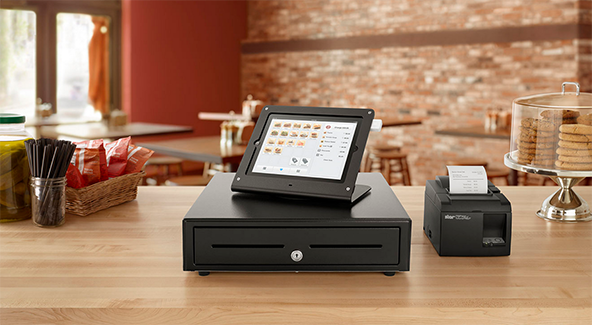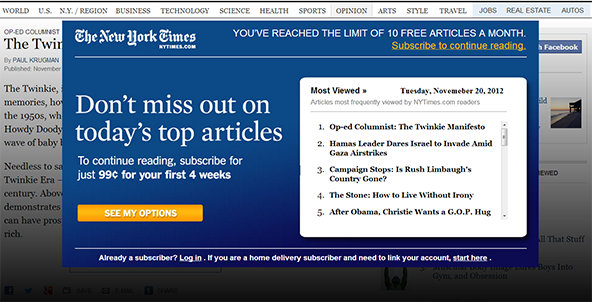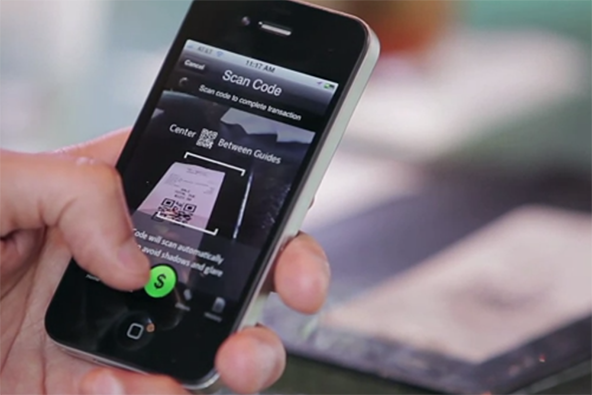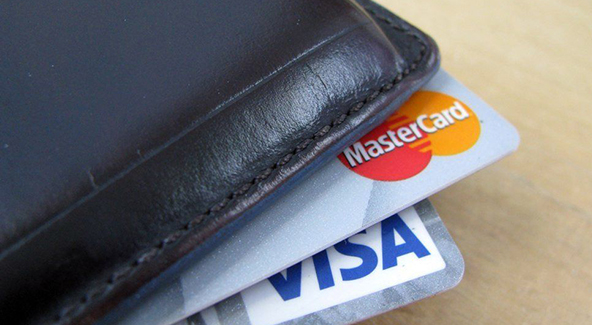Square’s ‘Business in a Box’

As the legend goes, one day in February 2009, San Francisco-based glass artist Jim McKelvey wasn’t able to sell a piece of his art, because he couldn’t accept a credit card for payment. Suitably distraught, the artist proceeded to tell his friend Jack Dorsey of his plight and Dorsey did what any true friend would have done in his place: a few days later he created a business that was to put McKelvey, his fellow artists and everyone else who wasn’t able to take credit cards out of their misery. The start-up was named Square.
A couple of years later, having enabled individuals to accept cards, Square turned its attention to real businesses and last March the company launched a new app that turns an iPad into a full-fledged point-of-sale (POS) terminal. Register, as the app was called, was a cool-looking and versatile product, which gave even the smallest of merchants the type of credit card acceptance capabilities and business management tools that were, until then, available only through high-end, clunky and expensive POS terminals. The processing costs were high, but many merchants did switch to Register all the same. And now Square has stepped up its efforts by repackaging and rebranding its merchant offering. I think it is fair to say that at this point individual users who might accept a couple of payments a year are a mere afterthought for the start-up.
Square’s ‘Business in a Box’
Square’s latest version of its Register service is called ‘Business in a Box’. Now, the processor attempts to present it as an entirely new offering, but it is not. ‘Business in a Box’ is merely an upgrade, but a characteristically well-designed and nicely packaged one. The system includes two Square card readers, an iPad stand, a cash drawer, and an optional receipt printer, which all connect wirelessly with the iPad-powered Square Register app. The package costs $599 with the printer or $299 without it and is fully refundable within 30 days, should the merchant decide to return it. The whole system is very simple to set up, as the following video illustrates:
As Bloomberg’s Danielle Kucera notes, Square’s ‘Business in a Box’ is a direct competitor to Intuit’s QuickBooks Point of Sale system, which sells for about the same price, but includes a bar code scanner, which Square’s package does not.
Square Register Is Still not the Best Choice for Most Merchants
Now, cool as Square Register may be, the start-up’s payment processing fees are still too high for most merchants. Just to remind you, Square is offering two different pricing structures. Under the original one, all card swiped transactions — debit or credit — are processed at a rate of 2.75 percent of the sales amount and all key-entered payments — at 3.50 percent plus $0.15. For perspective, a traditional processor would charge a small merchant something in the neighborhood of 1.65 percent for a swiped credit card transaction and perhaps up to 3 percent for a key-entered one. But the biggest difference is to be found in the cost of accepting debit cards, which in the post-Durbin world would be more than a percentage point lower than the one for credit cards.
But then in August of last year, Square introduced a flat-fee monthly plan, under which merchants would pay $275 per month and 0 percent per swiped payments for transaction amounts under $400 and for a monthly sales volume of up to $21,000 (about $250,000 annually). Any single swiped payment for amounts over $400 and any swiped transaction over the monthly limit of $21,000 is processed at the standard rate of 2.75 percent. Key-entered payments are all processed at 3.50 percent plus $0.15 per transaction, irrespective of the amount or monthly volume. Assuming that the average sales amount is lower than $400, at $275 per month, the flat-fee plan makes sense for all Square merchants processing more than $10,000 in swiped transactions, on a monthly basis, but not for merchants processing less than that. So, if you are a Square user and your monthly processing volume is higher than $10,000, you should switch to the monthly plan — there is no reason not to and it can save you a lot of money. For example, if you switched to the flat-fee plan and accepted $20,000-worth of swiped transactions over the course of the next full month, you would be charged twice less in processing fees than you would have paid if you had stuck to the pay-as-you-go arrangement. So how does Square’s flat-fee plan compare to a traditional processor’s interchange-plus model? Well, I did the comparison when I initially reviewed Register:
In the post-Durbin world, debit transactions are processed at an interchange rate of 0.05 percent plus $0.22 per transaction, which translates into a weighted average of about 0.63 percent or so. Under Square’s flat-fee plan, the lowest possible rate you can get, achieved if your annual volume were precisely $250,000 and consisted solely of swiped transactions, is 1.32 percent. And I keep repeating “swiped”, because Square will still be processing key-entered transactions at the very high rate of 3.5 percent plus $0.15.
It is true that the interchange rates of all types of credit card transactions would be higher than 1.32 percent, but remember that this is the best possible processing rate a Square merchant could hope for and one that, in all likelihood, will never be achieved. Real world Square merchants would be paying a higher, often much higher, average rate. Moreover, merchants’ processing volumes are made up of a mixture of credit and debit transactions and the bigger the share of the latter group, the lower the overall processing rate. It is impossible to make a precise calculation, but a back-of-the-envelope one tells me that, if half of your card transactions were debit and you had signed up for a reasonable interchange-plus pricing plan, it is very unlikely that the Square flat-fee plan would be better, even under the best of circumstances.
Considering that the $400 upper transaction limit did not exist when I wrote this, my conclusion is even more valid today.
The Takeaway
Now, I should note that my pricing considerations apply solely to the pricing model that is stated on Square’s website. What do I mean? Well, the thing is that no big merchant will ever accept either of Square’s pricing models. And no, Starbucks did not accept it either when the two companies announced their partnership in August of last year. Jack Dorsey did hint that Starbucks was getting a special treatment, although he did not elaborate. And anyway, how would Starbucks justify to its shareholders a decision to switch to Square’s higher processing fees? It could try to go with the “Square is so cool” line, but something tells me that it is not going to fly.
So Square is now big enough to be able to give the big retailers what they want, at a price they can tolerate, and is nifty enough to win over smaller businesses, even as it charges a bit more than they would otherwise might pay. A job nicely done.
Image credit: Squareup.com.



Until Square finds a way to handle customer service questions and complaints without the hassle of sending a email and waiting for a answer… most major merchants will shy away.
I don’t see where you factor in monthly bank fees when you declare Square is expensive. Wireless bank fees can run $100/month before u ever swipe, key, etc any transactions. AND you have to buy or lease a very expensive “CC machine”.